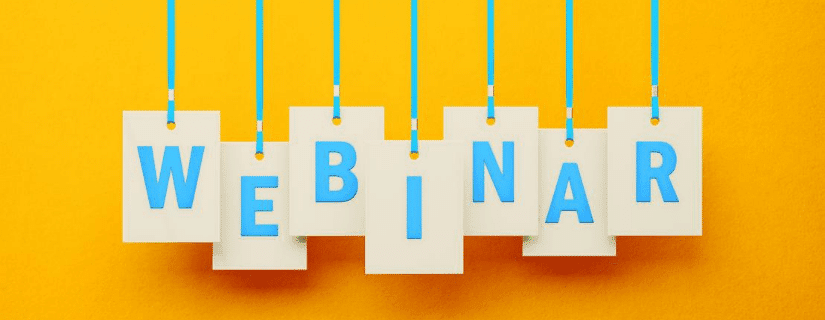

Webinars have been around since the 1990s, but they have only now taken off big style. A cheap and accessible means of talking to more customers, webinars have much appeal.
When encouraging your customers to engage in a webinar, your invitation is worth considering. Figuring out how to appeal to thousands of subscribers isn’t easy. You need to know which elements are worth including in your invite to make sure as many people as possible attend.
Let’s take a look at some of the top elements of a good webinar invitation email.
1. Send a series of emails
Email marketing is an essential part of your webinar marketing plan.
Your webinar invites should follow one after another in the run-up to the event. By doing this, you can build anticipation for your webinar and encourage attendance.
You can automate your webinar invites to reach your customers’ inboxes over a period of time. Each invite should add something new to the story.
You may want to send out a different email for each of your webinar focuses – but don’t overdo it. Three emails maximum is ideal. You don’t want to spam your customers, which is always a turn-off.
Send your next webinar emails with Sendinblue!Get started on our free plan with 300 emails/day, unlimited subscribers, and access to email design features. Open my free Sendinblue account. |
Follow-up email reminders
Another way to ensure your customers pay attention to your email is to set up an automated reminder. If your customers haven’t opened the initial invitation, send a follow-up email.
Generally, your first email would pitch the webinar and share the time when it will be held. In the next five days you may check with your subscribers again, reminding them that the webinar will take place in a few days. This is a good opportunity to change the wording and try to convert those who have not yet confirmed their participation.
It is always a good idea to send an email on the day of the webinar. You will remind those who confirmed that it is starting and try to convert additional “late comers”.
In some circumstances you can schedule an additional email an hour later (or just a couple of hours before the webinar). This email should be sent only to those who did not confirm their participation, again, with the goal of getting them to attend.
Make sure you’re not too spammy. This usually works with people who confirmed following a “save the date” but did not make a final confirmation. Or a smaller group, where you know they’re likely to be interested in what you have to say.
Below is an example of an automated series of webinar invite reminders. The wording has been adapted in the second email, which avoids them appearing to be duplicates and looking unprofessional. Additionally, there may be customers who weren’t intrigued by the wording in one email. A second email may be all it takes to win them over.
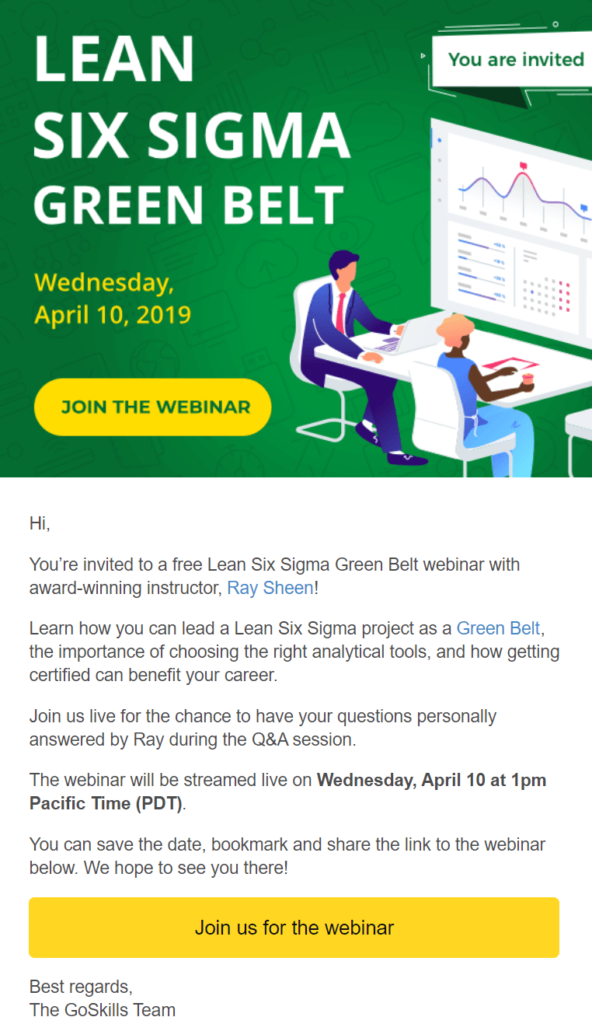

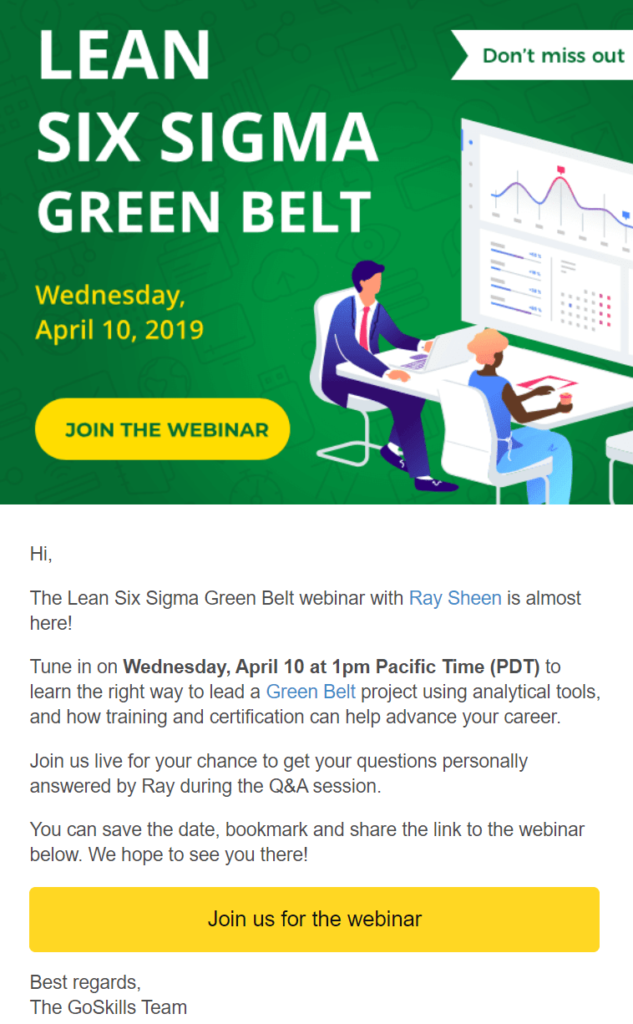

2. Have an appealing hero image
Your webinar invite’s hero or banner image is what captures the attention of your customer. Keep this in mind when choosing an email template.
One of the most important rules of a good banner is to add a call to action. If your target audience doesn’t want to spend time reading your email, they’ll likely look at the banner. It will help your recipients understand the purpose of your invite with minimal reading.
Many people assume that the more complex the banner, the better. This couldn’t be further from the truth. The best banners are those that have plenty of white space. You don’t want to overwhelm your reader. The point is to get across the purpose of your webinar as simply as possible.
Here’s an example of a clean, clear webinar invitation banner:
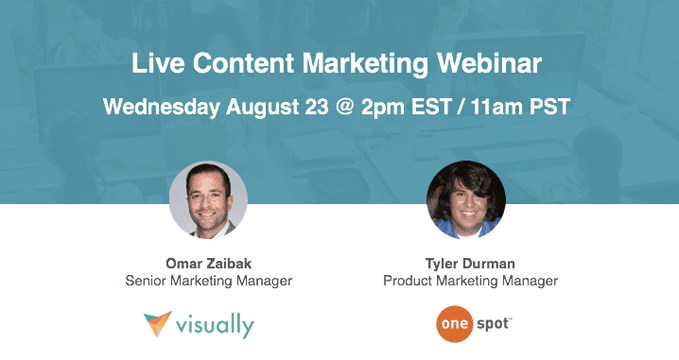

3. Include plenty of calls to action
The whole point of your webinar is to encourage customers to register for the event. If you don’t have calls to action throughout your email invite, you will find it difficult to achieve this.
There is a fine line between natural and spammy calls to action. You need to include them in the right locations on your email and banner.
Consider a call to action at the very start, middle and end of your email, and one on your banner. You can prompt a customer to register for your webinar whenever they feel most intrigued. It’s hard to predict what will entice each customer, which is why more than one call to action is best.
The example below shows how to add calls to action to a webinar email invite. The company, Bizzabo, has included three calls to action: one in the banner, and two in the email copy. Because each call to action has different wording, it doesn’t stand out as repetition.
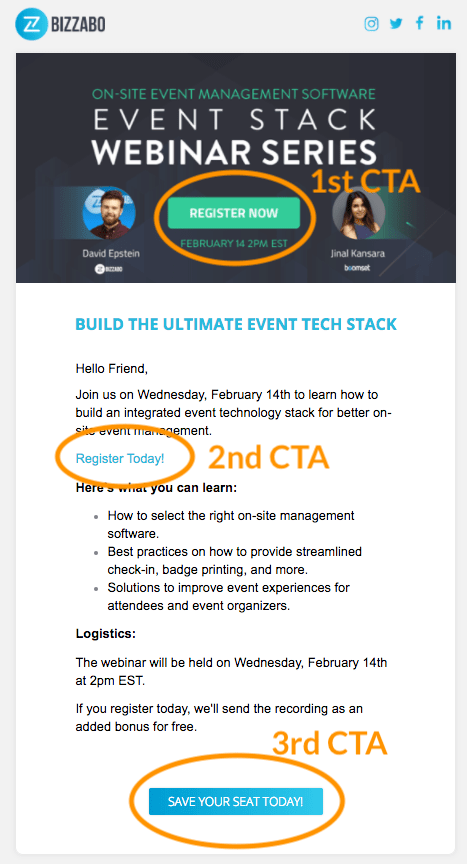

4. Keep your copy brief
An important means of marketing your webinar is to keep it simple. The longer and more complex your email copy, the more of a turn-off it is to your subscriber.
Your email invite is the first impression you can give a customer about the webinar itself. If the email is long and rambling, who’s to say the webinar won’t be the same?
There is also a practical benefit of shortening your copy: people are more likely to read it. Nobody has the patience for time-wasting activities anymore. That includes reading long emails.
Your email copy need only highlight the most relevant details about your event. If the webinar is covering a topic that is helpful or appealing to an audience, you’ll sell it by the title alone.
Let’s take a look at a good example of a business that keeps its webinar invitation copy brief. Asana’s email banner is succinct and to the point. The email copy contains a short opening, followed by three bullet points. This short text is manageable for all readers.
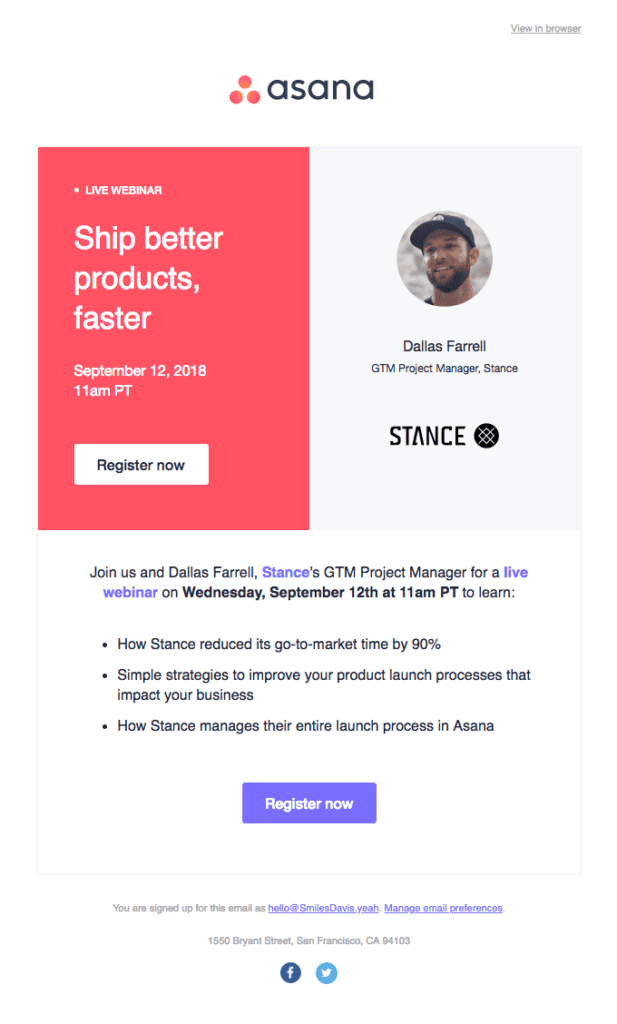

5. Create a catchy subject line
Your webinar email subject lines are what prompt the recipient to open your email in the first place. For that reason, the importance of a catchy headline cannot go ignored.
You need to be able to convince your customers to give up their time for you. That’s no easy feat. In fact, it’s difficult to even persuade a customer to open their email, which takes one minute at most.
Having a good subject line is easy if you’re hosting a good webinar. Your webinar will sell itself – you just need to get people onto the email. A punchy subject line relating directly to your webinar will do this.
Your webinar should discuss how to solve a major problem for your customer. You also need to prove that you will be approaching this topic in a completely unique way. Otherwise, people will go elsewhere to look for a quicker or more accessible solution.
The email below used an effective subject line about the webinar that is both catchy and intriguing: “Our on-demand webinar shines a light on Dark Mode”
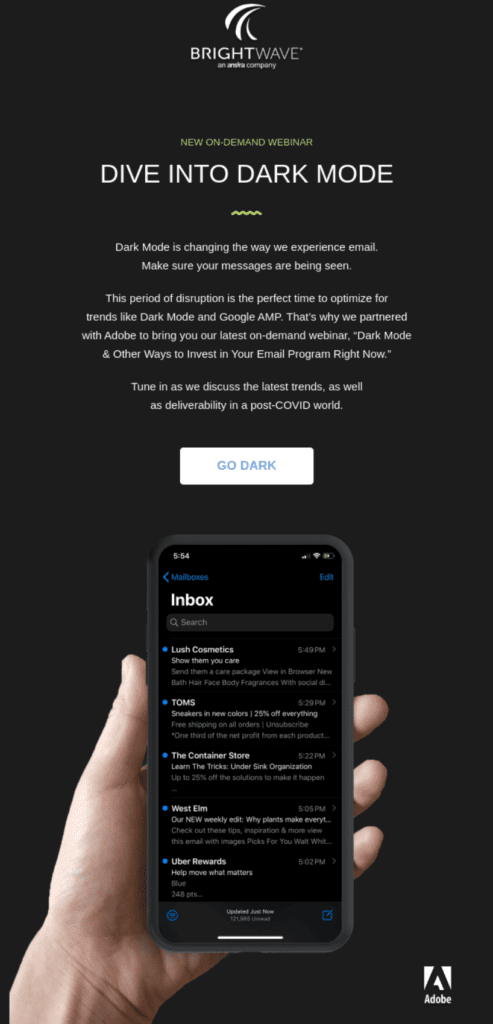

6. Set an agenda
Every webinar should have a clear agenda. You need to make sure that your webinar invitation email refers to this agenda in enough detail.
Your customer should know exactly what to expect before the webinar. This is important because they need to know why it’s worth their time, and what they can learn from it.
Not only that, but a misleading invitation can leave the customer feeling cheated of their time. The webinar ends, and they realize you haven’t covered half of what you promised. If there was ever a quick way to lose the trust and respect of your customers, it’s through failing to meet expectations.
If you’re planning to host a big webinar that covers many topics, laying out your agenda is very important. This is because your webinar’s title is most likely quite generic. It may not capture your customers’ attention – but your sub-topics will.
Hasselblad’s webinar invite below utilizes a bullet point list to set the agenda. Each point in the list is unique from the other, demonstrating that the event will cover a broad range of topics.
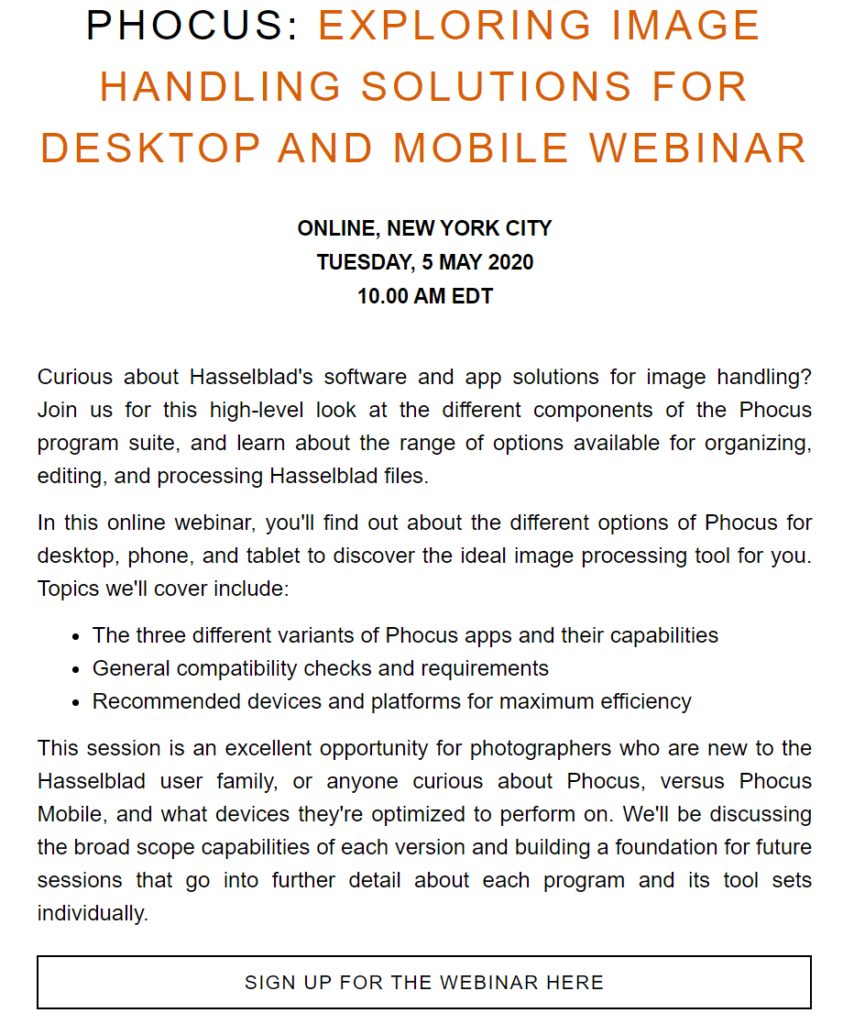

7. Talk to your audience
No matter how professional you aim for your webinar to be, you should remember who you’re talking to. The people in your audience are human beings; they enjoy relating to other human beings.
The best way to catch your reader’s attention is to speak to them on a personal level. If you set out your invitation like a business report, your customers will lose interest. They might not even finish reading the email.
Speaking to your customers human-to-human is much more likely to engage them. You can pull your reader in by asking a direct question or making a relatable remark. Humour is also very effective when done the right way.
The point of your email invitation is not to dumb down for your audience, but to speak to them as a person. You can also give your audience an idea of your own brand, your voice, and what you stand for. Giving off a friendly impression is as important as being professional.
Unbounce offers a fantastic example of a personal webinar invite email. The first few lines of copy open the email in a fun, cheeky tone that customers can immediately warm to. The question mark is cleverly used to draw attention from the get-go.
By the time Unbounce introduces the webinar, they already have many readers on their side.
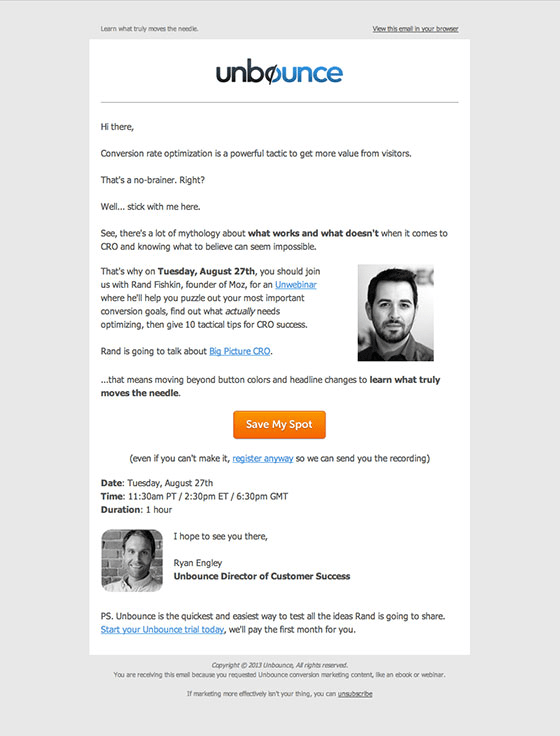

8. Sell purely with text
Imagine if you had no choice but to send your webinar email invite with no graphics – just a page of text. Would you think in greater detail about what exactly you were writing? Would the importance of the words weigh heavily on your shoulders?
This is how you should feel every time you produce a webinar email invite, even when adding graphics. Condition yourself to write your copy under the pretense that it will stand alone. It will help you to put much more focus on your written words.
You can never assume that your audience will only take interest in your graphics. For every person who does, there may be someone else who finds your copy much more important. If your words don’t sell, neither will your webinar.
There are examples of webinar email invites that contain only copy. Providing your content marketing skills are on point, there’s no reason why you can’t do the same.
The invitation email below, for instance, is short but sweet and uses strong copywriting to build a rapport with subscribers.
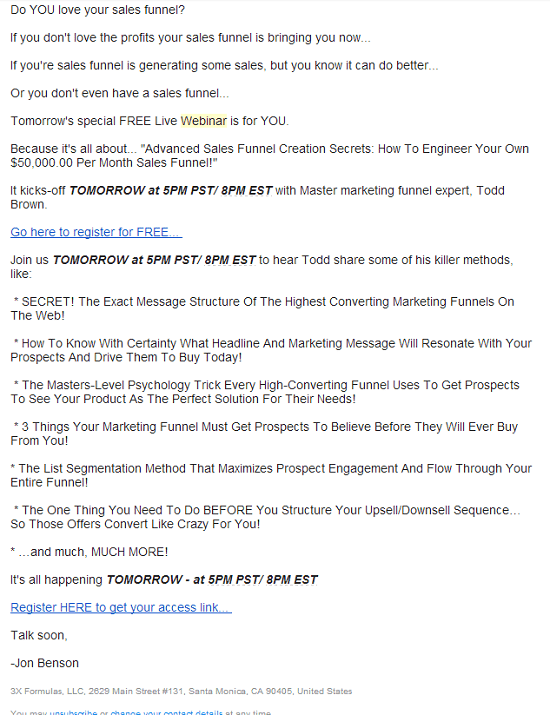

9. Use animations wisely
There’s nothing that quite draws the eye than an on-screen animation. Using email GIFs is a great way to visually entice your subscribers to read what you have to say.
The trick with animations is to keep them under control. A page full of blinking, blurring, bouncing, and dancing GIFs will terrify your reader. Using a single relevant GIF is much more effective.
Consider adding a GIF from a well-known TV show, like Friends, providing it is relevant to what you have to say. Drawing the reader in with some well-placed humor will always work in your favor.
A static email design won’t quite delight your reader like a GIF will. And remember, you don’t have to use GIFs just to entertain or provide comic effect.
Adweek chose to use an animation that has a shock factor. The reader, wanting to know why the person’s face was blurred out, would read the text to learn more. Here, they’d discover the purpose of the webinar, along with a call to action in bold red print. This is a great way to make the audience feel almost as if they have to take action.
Boost Sign-Ups With Your Next Webinar Invitation Email
In times when webinars are gaining popularity day by day, it is increasingly difficult to compete with others, let alone stand out.
As you can see from this post, the usual themes that you know from email marketing repeat themselves – clear message, catchy headline, easy instructions…
While you may see many companies doing crazy things with their webinar invitations, following tried and tested methods is most likely to bring success.
Users’ attention is very valuable, as is their time. A short and clear message will always convert better than an overcomplicated one.
Overlooking your webinar email invitation is never a wise idea. Be sure to dedicate maximum time and effort to producing email invites to the best of your skills. Hire a content expert if you prefer. But you’ll nearly always find that you’re more than capable of the job yourself.
 Deutsch
Deutsch




















